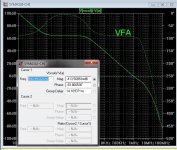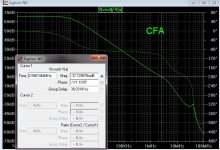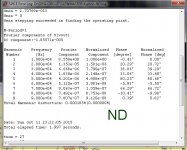7 nV/sqrt(Hz) noise is 120 dB S/N re 1 V - and that's flat, a bit better weighted
10 kOhm Volume pot is on low side - gives ~ that 7 nV number worst case
I really don't think 1 nV en input is needed at a power amp input with any rational gain structure
I expect to see 500 W amps with <90 dB sensitivity speakers in the home
THX only calls for 85 + 20 = 105 dB for mains, + 10 dB for sub-bass LFE is still < 120 dB
and given human hearing sensitivity you don't really need even 100 dB S/N below 100 Hz
10 kOhm Volume pot is on low side - gives ~ that 7 nV number worst case
I really don't think 1 nV en input is needed at a power amp input with any rational gain structure
I expect to see 500 W amps with <90 dB sensitivity speakers in the home
THX only calls for 85 + 20 = 105 dB for mains, + 10 dB for sub-bass LFE is still < 120 dB
and given human hearing sensitivity you don't really need even 100 dB S/N below 100 Hz
Two very different amps
Yes VERY different, but to my eye and with what measurements are available, both should be transparent in all sane cases. My pocket cannot afford the Pass labs unit, so I cannot tell you what my ear actually hears.
I agree by and large. As said earlier it's more about marketing and bragging rights.7 nV/sqrt(Hz) noise is 120 dB S/N re 1 V - and that's flat, a bit better weighted
10 kOhm Volume pot is on low side - gives ~ that 7 nV number worst case
I really don't think 1 nV en input is needed at a power amp input with any rational gain structure
I expect to see 500 W amps with <90 dB sensitivity speakers in the home
THX only calls for 85 + 20 = 105 dB for mains, + 10 dB for sub-bass LFE is still < 120 dB
and given human hearing sensitivity you don't really need even 100 dB S/N below 100 Hz
I expect to see 500 W amps with <90 dB sensitivity speakers in the home
There was the guy with 103dB horns and kw crown amps posting on here earlier in the year!
THX only calls for 85 + 20 = 105 dB for mains, + 10 dB for sub-bass LFE is still < 120 dB
and given human hearing sensitivity you don't really need even 100 dB S/N below 100 Hz
In reality I'm not sure most of us can justify more than 80dB S/N due to the presence of noise sources. Even a watch could screw things up! Certainly at 120dB S/N you can say 'stupid low no need to go further'?
But I recall when Keith O. Johnson mentioned JFETs in the front end of a Spectral amplifier and said that they were smaller-geometry devices than might have been used, hence slightly higher noise, but that they were better for other parameters including bandwidth and fast settling.
That's referring to the NPD5566 dually, Mr Wood ?
Once again :-(
Horns are certainly more accurate than cones of dynamic speakers, when correctly designed, with a good driver. They allow a 700/ 16000 range from an unique point source, and you know the benefit.
Hi ---- my first system was DIY from JBL drivers.... midrange horn with 90 degree lens. I would like to hear a good horn ssytem again....... are the drivers you used still made and do you have schematic/box info? Do you like other horn and bass drivers that are better today?
THx-Richard
That's referring to the NPD5566 dually, Mr Wood ?
Those are the parts I designed in at Spectral. Keith has been massaging the basic design with a few tricks since then. Later they were looking for an alternative, especially since the NPD5566 was discontinued. I'm not aware of what they are using today.
Demian speaks sooth.That's referring to the NPD5566 dually, Mr Wood ?
Paul Klipsch in his last years was developing newer designs with shorter bass horns (by starting from a larger throat) and modern upper-range horns, to be called the Jubilee. I'm surrounded, here in Klipsch territory, by friends with various DIY all-horn systems, and can vouch for the results.
Other folks, notably LeCleach, have tackled the error-filled assumptions of classic "exponential" flat-wavefront horn contour design. There's *lot's* of room for horns in a modern context, but it'll require throwing out a lot of old history, including almost any sound reinforcement practice.
All good fortune,
Chris
Other folks, notably LeCleach, have tackled the error-filled assumptions of classic "exponential" flat-wavefront horn contour design. There's *lot's* of room for horns in a modern context, but it'll require throwing out a lot of old history, including almost any sound reinforcement practice.
All good fortune,
Chris
Meyer and I discussed Klipsch's K-horn limitations more than 40 years ago, and John Meyer also concluded that Klipsch should have started with a larger throat in order to reduce the delay path. We should not blame Paul Klipsch too much, because at the time of the K-horn design, the ear's sensitivity to path length was almost ignored by scientists. It was called Ohm's Law of Acoustics, and implied that the ear was essentially phase/delay deaf until you could detect two separate sources.
The number of transistors I mentioned vs distortion is a general guideline. Note the test frequency.
OS, what's the HF loop gain on your two amps? Are they the same?
It's interesting how the harmonic structure is different. With VAS loading, you can tune the balance between the seconds and thirds.
The VFA (below 1) , The CFA (below 2) both 67db@ 1K ... but the
CFA's ULGF is 2.6mhz. No way to have two radically different designs be
exactly the same.
Now , even a 8 device ND can actually do better than the VFA.
You actually could drop the VAS cascodes and mirrors , leaving
just the 4 CFA "core" transistors and the 2 super-pairs (8 devices).
You would still end up with (below 3 @ 1ppm).
The super pair makes all the difference , same CFA with a standard
or hawksford VAS is always 20-30PPM.
As far as the "poor" VFA (symasui) , it sounds better than any blameless.
Perhaps why the original symasym has many fans. I built
it last .... I did not think it could be as good as the CFA.
I've listened to both at higher powers , the CFA's brushes , finger snaps
(Alan Parsons) ... just a bit more detailed with a different placement
in the room. "expansive" ??
OS
Attachments
I've listened to both at higher powers , the CFA's brushes , finger snaps
(Alan Parsons) ... just a bit more detailed with a different placement
in the room. "expansive" ??
OS
what are the Slew Rates of VFA and CFA?
THx-RNMarsh
what are the Slew Rates of VFA and CFA?
THx-RNMarsh
Both are SOTA , for a VFA ... the sym is a @100V/us.
The CFA with the super - pairs is >400V/us. With no load on the CFA "core" ,
"current on demand" just makes the "core" that much faster.
On my first round of CFA's , the "suppression" >20ma was not present.
The super pair one is different. Super - pair is like a symmetrical beta
enhancement (like the blameless).
And we get even better THD than a blameless. Mr. self argued that I
could not get a CFA to match his blameless. I do not agree , ND beats
the blameless - easily. It even exceeds a TMC VFA at higher levels.
It's no "magic" , having no load from the VAS on the 2'nd stage of the CFA
gives 10X better cancellation. The same improvement the blameless enjoys
from it's beta enhanced VAS. Quite a predictable improvement.
PS - not to brag , but thimios had the ND producing perfect 200K square waves.
OS
Last edited:
Agree. And I admire the German talent to make believe the entire world that their products are "solid" and 'quality', while most of the Japanese cars are ten time better ;-)
Crhistophe, like it or np german cars ARE better made than most others. I think the only popleo wh van comprte with hem ade SOME Japanese manufacturers.
A very good friend of mine works in BOsch, on electronic fuel imjevtiom systems. He says that the working order of the day in Bosh is "Beware of the three F" (Fiat Ford and the French). He could not expliam what was Ford doing in that company. Fiat he says is generlly half baked, models never evolved as much as they can be, always loose ends. The French fall into two groups - the Peugeot/Citroen group, whih tend to use the chespesat materials thy can find and because nonody in Europe can forgiver the Peugoet group for effectivly destroying CItoe, turnng it for a glorlious tour de force in technology to just another run off the mill car, as dull as Peueot's. Renaul however is a different story, tey seem to be holding on to traditional mesures of value.
As opposed to that, the Japanese, and especilly Toyota, are their nigtmare. They know that every time they inform their customers that thwy chnaged the size of two screws, a Toyota delegaion will be around to be thoroughly briefed because they insist on being intimately briefed on each and every change, no matter how minor. Their point being in ultimate reliability.
By coprison, maaping out Peugeot/Citroem's mew 1.7 litre diesel engine an into problems, at ound 3.000 rpm, the engine started vibrating. Eventully the solution was to use a fuel pipe about 2 cm lonhger and Bosch informed Peugeot about it. Did they changa? No, because that would have cost them one euro extra.
In the luxury segment, the new Maserati Ghigbli limo with a diesel engine willnot be sold in the US because its MV motori (subsidiary of FIAT specializing in diesel engine) 3 litre V6 imply cannot be programmed to pass pollution tests of California. The Ferrari designed 3 litre petrol V& had no such problms, either in its basic 330 hp form, or in its developeed 410 twin turbo hp form.
Well traditionally they used a GM gearbox!
So what? Many Mercedes-Benz and BMW models use ZF gearboxes. One out of house part in all it takes to make a whole car is hardly a problem. And it's a highly specialized part, the semi-automatic electro-assisted gearbox. It's logical that such speialist parts will be designed by specialist companie for cost effectiveness. In the days of carburaators, only FoMoCo (Ford Motor Company) me their oen carbs, everybody else bought them fro specialist companies (Rochester in the US, Weber Marelli, Zenith-Stromberg, SU and others from Europe).
Demian speaks sooth.
Good thing Mr. Martin is around.
(they'll still drag me off in a straitjacket one day)
So what? Many Mercedes-Benz and BMW models use ZF gearboxes. One out of house part in all it takes to make a whole car is hardly a problem.
Just popping your argument. If one subassembly can be bought in, why not two, why not 3? What is the line at which a car stops becoming the product of one country? Or in fact does it matter as long as the thing works as intended?
A business partner of my fathers used to have old bentleys restored for him. I saw one chassis for a 4.5 litre that had holes for 3 different bodies on, so it had clearly been to the coachbuilders a couple of times for re-purposing. Still a Bentley restored in any of those forms. OK the purists will say he cheated putting a rootes blower on it as only 50 odd of those were made. But the finished article looked gorgeous. Would I drive it on the road? Hell no.
I am glad to hear that, considering the runaway acceleration scandal cast considerable recent doubt on their QA culture....
As opposed to that, the Japanese, and especilly Toyota, are their nigtmare. They know that every time they inform their customers that thwy chnaged the size of two screws, a Toyota delegaion will be around to be thoroughly briefed because they insist on being intimately briefed on each and every change, no matter how minor. Their point being in ultimate reliability.
Toyota was also a Harman nightmare, for the talk-the-talk and maybe not walk-the-walk characters within the Harman-Becker group, when I was there. They would descend en masse on the factory in Northridge and insist on mingling with the line workers. They did not submit to a "stage-managed" presentation and long lunches, but asked the workers point-blank questions about their understanding (!) of what they were doing. One martinet's ultimate horror, and it couldn't have happened to a nicer guy
To develop even the possibility of business with Toyota, one man lived in Japan for many years, married a Japanese wife, and went through certain ritualistic bonding practices that are not appropriate for description here. Finally Harman got to do one NON-branded amplifier for a particular model. That unit forced the purchasing people to source 0.1% tolerance resistors (more horror, back in those days; now of course thin film 0.1% parts are routine). This was required to get adequate common-mode rejection with the pseudo-differential front end.
Later, Harman was the only company to bid on audio systems for a new Lexus, and signed up for zero defects. In addition Manufacturing assured everyone they could handle 0402 parts. More disasters working through that.
The aforementioned little dictator with an abiding hatred of engineers, when a switchmode amp's designer said they must hand-insert electrolytics to place them as close together as possible for low inductance, responded by writing into the design for manufacturing manual: NO class-D amplifiers.
As I say, and will likely say many more times: you can't make this stuff up.
- Status
- Not open for further replies.
- Home
- Member Areas
- The Lounge
- John Curl's Blowtorch preamplifier part II


